Thursday, February 18, 2010
Blog moved!
Thanks everyone for your patronage. My blog is now hosted at http://www.visualquotient.net/index.php/blog/.
Thursday, July 30, 2009
Doddamakkali - Pristine wilderness. Well...almost.
Tucked away amidst the rolling hills of the Cauvery Valley lies the beautiful riverine beach called Doddamakkali. The Cauvery flows deceptively calm here - just a few metres away, it forms rapids. A few kilometres upstream lie the mighty Shivanasamudra falls. If you float downstream by around 6 km, you would reach Bheemeshwari.
Doddamakkali is a small camp run by Jungle Lodges and Resorts. The camp has 10 tents and the trademark Gol Ghar for dining.
Vineet and I set off on a 2-day trip to Doddamakkali in the last week of July. Enroute birding was minimal as we set off pretty late in the morning. The highlight was a bridge off Maddur where we saw House swifts in frenzied activity. Investigation under the bridge revealed nests! And it was the first time ever that I saw a House swift completely (usually its only a fleeting glimpse in flight).
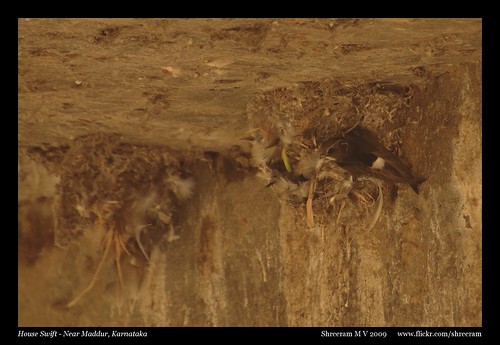
We were welcomed at JLR with puzzled faces. The camp was not informed of our arrival (possibly due to erratic telephone connectivity). Then they swung into action. Within 10 minutes, our tent was ready. In half an hour, we were treated to a simple yet sumptuous lunch. This JLR camp definitely has 10/10 service!
Doddamakkali is a treat for the nature-lover. An amazing array of flora and fauna greets the visitor there. The grandest of them, for me, was the Grey-headed Fish Eagle that seems to be resident in the camp. Perfectly camouflaged in the leaves of the tall trees it usually sits on, this beautiful bird can be seen flying all along the camp and crossing the river both sides throughout the day.

Many other birds made frequent appearances around the camp. The resident Grey Hornbills' calls initially made us look out for Black Kites. A Brahminy Kite and Common Kingfisher competed with the Fish Eagle for food. We saw many Great Cormorants flying upstream. The resident White-browed Wagtails tempted us to photograph them, only to fly away at the last moment. A male White-naped Woodpecker showed himself just as we were leaving.
On the plateau above, we saw Jungle Bushquails on 3 separate occasions. And again, the first time I saw them for such a long duration. Common Woodshrikes, Eurasian Collared Doves, Black-rumped Woodpeckers and Streak-throated Woodpeckers were having a ball of a time. A few eagles (one pair of Short-toed Serpent Eagles; need to id the remaining) were scanning the countryside for food.

A great sight at the camp was the hundreds of Blue Tiger butterflies clinging onto the same tree, with some Common Crow butterflies amidst them. Tried my hand at photographing them but the light just wasn't right! We noted at least 13 different species of butterflies at the camp. I am sure there were many more...
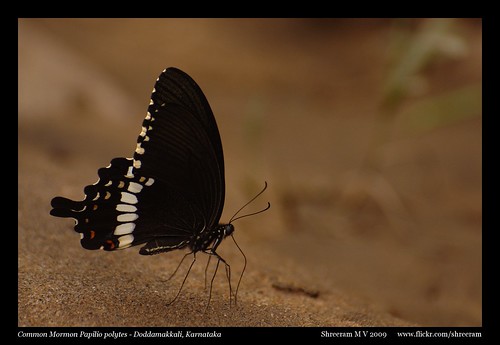
Indian Grey Mongooses were a common sight around the camp. We didn't see any Giant Squirrels or Otters. Chital seemed to be rare, with 2 glimpses in the plateau. A wild boar ran within 50m of us on one of our treks. Bonnet macaques were plenty in the camp.
We were also witness to some very unfortunate poaching activity in the river. We were warily approaching the Fish Eagle in the photograph above to get a close-up shot. Suddenly, a huge "BOOM" ringed through the air. As I regained my senses, I saw poachers on the other bank pulling out dead fish from the river. We later got to hear from the JLR folks that this is a regular occurrence. When they tried to counter the poachers last time around, they were pelted with stones and dynamite.
Things to do:
1) Nature-watching - The best thing to do there!
2) Trek along the rocky shoreline, interspersed with beaches. It's very tiring. Remember to carry a bottle of water with you.
3) Trek up the hill behind the camp. Beautiful landscapes beckon on this trail. A bit slippery in the beginning.
4) Drive up to the plateau and nature-watch.
5) Beach volley-ball.
6) Coracle ride.
How to get there?
Drive to Maddur on the Bangalore-Mysore road. At Maddur, take the diversion towards Kollegal. Drive on the Kollegal road till you see a board on the left-hand side which says Shimsha Hydro-electric project. There is also a smaller board mentioning JLR. Drive down the road till the Shimsha project gate. There's another gate on the right hand side, leading to a mud road, that you'd need to take. Sign into the register there and drive through 8 km of mud road and descending ghat road to get to Doddamakkali.
Things to keep in mind:
1) The camp has limited electricity. There are a couple of electric lanterns and a fan that run at night. You can charge your mobiles and camera batteries in the extension cords there.
2) Very limited mobile connectivity. Airtel works in a couple of places around the camp, sometimes. There is a Reliance coin-operated telephone in the Gol Ghar.
3) The last 8 km drive is on a mud road, with rocks scattered. Please keep your spare tyre in good condition.
List of Birds and Butterflies: Link
Doddamakkali is a small camp run by Jungle Lodges and Resorts. The camp has 10 tents and the trademark Gol Ghar for dining.
Vineet and I set off on a 2-day trip to Doddamakkali in the last week of July. Enroute birding was minimal as we set off pretty late in the morning. The highlight was a bridge off Maddur where we saw House swifts in frenzied activity. Investigation under the bridge revealed nests! And it was the first time ever that I saw a House swift completely (usually its only a fleeting glimpse in flight).

We were welcomed at JLR with puzzled faces. The camp was not informed of our arrival (possibly due to erratic telephone connectivity). Then they swung into action. Within 10 minutes, our tent was ready. In half an hour, we were treated to a simple yet sumptuous lunch. This JLR camp definitely has 10/10 service!
Doddamakkali is a treat for the nature-lover. An amazing array of flora and fauna greets the visitor there. The grandest of them, for me, was the Grey-headed Fish Eagle that seems to be resident in the camp. Perfectly camouflaged in the leaves of the tall trees it usually sits on, this beautiful bird can be seen flying all along the camp and crossing the river both sides throughout the day.

Many other birds made frequent appearances around the camp. The resident Grey Hornbills' calls initially made us look out for Black Kites. A Brahminy Kite and Common Kingfisher competed with the Fish Eagle for food. We saw many Great Cormorants flying upstream. The resident White-browed Wagtails tempted us to photograph them, only to fly away at the last moment. A male White-naped Woodpecker showed himself just as we were leaving.
On the plateau above, we saw Jungle Bushquails on 3 separate occasions. And again, the first time I saw them for such a long duration. Common Woodshrikes, Eurasian Collared Doves, Black-rumped Woodpeckers and Streak-throated Woodpeckers were having a ball of a time. A few eagles (one pair of Short-toed Serpent Eagles; need to id the remaining) were scanning the countryside for food.

A great sight at the camp was the hundreds of Blue Tiger butterflies clinging onto the same tree, with some Common Crow butterflies amidst them. Tried my hand at photographing them but the light just wasn't right! We noted at least 13 different species of butterflies at the camp. I am sure there were many more...

Indian Grey Mongooses were a common sight around the camp. We didn't see any Giant Squirrels or Otters. Chital seemed to be rare, with 2 glimpses in the plateau. A wild boar ran within 50m of us on one of our treks. Bonnet macaques were plenty in the camp.
We were also witness to some very unfortunate poaching activity in the river. We were warily approaching the Fish Eagle in the photograph above to get a close-up shot. Suddenly, a huge "BOOM" ringed through the air. As I regained my senses, I saw poachers on the other bank pulling out dead fish from the river. We later got to hear from the JLR folks that this is a regular occurrence. When they tried to counter the poachers last time around, they were pelted with stones and dynamite.
Things to do:
1) Nature-watching - The best thing to do there!
2) Trek along the rocky shoreline, interspersed with beaches. It's very tiring. Remember to carry a bottle of water with you.
3) Trek up the hill behind the camp. Beautiful landscapes beckon on this trail. A bit slippery in the beginning.
4) Drive up to the plateau and nature-watch.
5) Beach volley-ball.
6) Coracle ride.
How to get there?
Drive to Maddur on the Bangalore-Mysore road. At Maddur, take the diversion towards Kollegal. Drive on the Kollegal road till you see a board on the left-hand side which says Shimsha Hydro-electric project. There is also a smaller board mentioning JLR. Drive down the road till the Shimsha project gate. There's another gate on the right hand side, leading to a mud road, that you'd need to take. Sign into the register there and drive through 8 km of mud road and descending ghat road to get to Doddamakkali.
Things to keep in mind:
1) The camp has limited electricity. There are a couple of electric lanterns and a fan that run at night. You can charge your mobiles and camera batteries in the extension cords there.
2) Very limited mobile connectivity. Airtel works in a couple of places around the camp, sometimes. There is a Reliance coin-operated telephone in the Gol Ghar.
3) The last 8 km drive is on a mud road, with rocks scattered. Please keep your spare tyre in good condition.
List of Birds and Butterflies: Link
Labels:
bangalore,
birdwatching,
Doddamakkali,
nature,
photography,
travel,
wildlife
Thursday, July 23, 2009
Agumbe - Monsoons, Rainforests and the King
Agumbe in monsoons is addictive! Many people I know are still unable to comprehend why I was in a place which gets the most rainfall in South India, that too at the height of the monsoons. It’s a joy that can only be experienced...

Along with a group of photographer-naturalists, I spent an extended weekend at Agumbe last week. Our base was the Agumbe Rainforest Research Station (ARRS). ARRS was founded by Romulus Whitaker to study the rainforest ecology. Their flagship project is the King Cobra project. These elusive giants are among the least studied animals in the world.
Our trip started off with a rather adventurous twist. For those not following the news, Karnataka’s coast has been battered by the monsoons. Most of the ponds and lakes are overflowing and the roads were flooded at multiple places. As our bus from Bangalore navigated through tyre-deep water (where cars and vans were stuck), we ran into electricity wires that were hanging low! A few tense moments and we realized that the place (luckily for us) had no power. The bus conductor, rather foolhardily than bravely, pushed the wires with a plastic bag and we took a deep breath again.

Monsoon is the best time to be in Agumbe. That’s when the forest comes alive. Streams turn into rivulets. Waterfalls abound. Raindrops fall on your head :). The fog turns it into a dream. Although most animals and birds are hard to spot in this weather, frogs, crabs and snakes appeared to be having a gala time.


The following is a list of frogs and snakes seen on the trip.
Frogs:
1. Rhacophorus Malabaricus (Malabar flying frog)
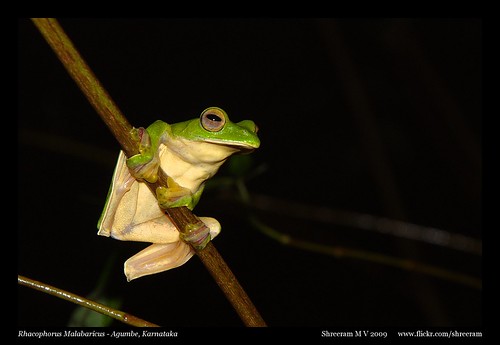
2. Duttaphrynus melanosticus (Common Indian Toad)
3. Sylvirana Temporalis (Bronzed Frog)
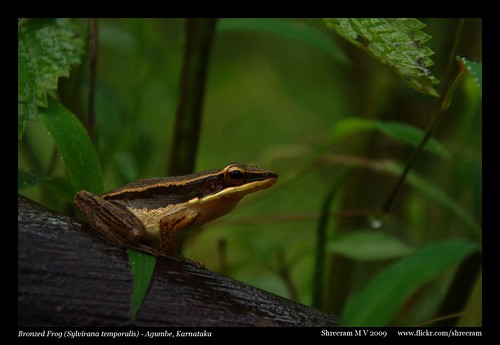
4. Philautus Neelanethrus (Blue-eyed Bush Frog)
5. Philautus Ponmudi (Ponmudi Bush-frog)
6. Philautus Wynaadensis (White-nosed Bush-frog)
7. Euphlyctis Cyanophlyctis (Common Skittering Frog)
Snakes:
1. Spectacled Cobra (Naja naja)
2. Hill Keelback (Amphiesma monticola)
3. Green vine snake (Ahaetulla nasuta)

4. Malabar rock pit viper (Trimeresurus malabaricus)
The thing with most of us city-breds is that rains automatically trigger an instinct to get indoors. I “suffered” with this for the first couple of days of my trip. I would get up to the sound of rain and would feel so thankful that I was indoors. Then, better sense would prevail on the purpose of my trip. I would slowly get myself into a raincoat, with my camera hanging on my side, and be off into the rains.

Leeches were a particularly interesting part of the trip. These slimy heat-sensing creatures come out of a long sleep at the onset of the monsoons and suck blood out of everything that moves. And they are everywhere. I was, admittedly, very scared of them for the first two days. I wouldn’t go out without leech socks and would scream when I found one of them on me. Then I saw a long stream of blood on my leg (from a leech that had had its fill and fallen off). And, leeches became a part of life.
I must thank ARRS for the fantastic experience. They helped us get around the rainforest and see the bio-diversity. They educated us on so many aspects, including how they track the King. The stay was homely and I still miss the simple food. Thank you guys!

Along with a group of photographer-naturalists, I spent an extended weekend at Agumbe last week. Our base was the Agumbe Rainforest Research Station (ARRS). ARRS was founded by Romulus Whitaker to study the rainforest ecology. Their flagship project is the King Cobra project. These elusive giants are among the least studied animals in the world.
Our trip started off with a rather adventurous twist. For those not following the news, Karnataka’s coast has been battered by the monsoons. Most of the ponds and lakes are overflowing and the roads were flooded at multiple places. As our bus from Bangalore navigated through tyre-deep water (where cars and vans were stuck), we ran into electricity wires that were hanging low! A few tense moments and we realized that the place (luckily for us) had no power. The bus conductor, rather foolhardily than bravely, pushed the wires with a plastic bag and we took a deep breath again.

Monsoon is the best time to be in Agumbe. That’s when the forest comes alive. Streams turn into rivulets. Waterfalls abound. Raindrops fall on your head :). The fog turns it into a dream. Although most animals and birds are hard to spot in this weather, frogs, crabs and snakes appeared to be having a gala time.


The following is a list of frogs and snakes seen on the trip.
Frogs:
1. Rhacophorus Malabaricus (Malabar flying frog)

2. Duttaphrynus melanosticus (Common Indian Toad)
3. Sylvirana Temporalis (Bronzed Frog)

4. Philautus Neelanethrus (Blue-eyed Bush Frog)
5. Philautus Ponmudi (Ponmudi Bush-frog)
6. Philautus Wynaadensis (White-nosed Bush-frog)
7. Euphlyctis Cyanophlyctis (Common Skittering Frog)
Snakes:
1. Spectacled Cobra (Naja naja)
2. Hill Keelback (Amphiesma monticola)
3. Green vine snake (Ahaetulla nasuta)

4. Malabar rock pit viper (Trimeresurus malabaricus)
The thing with most of us city-breds is that rains automatically trigger an instinct to get indoors. I “suffered” with this for the first couple of days of my trip. I would get up to the sound of rain and would feel so thankful that I was indoors. Then, better sense would prevail on the purpose of my trip. I would slowly get myself into a raincoat, with my camera hanging on my side, and be off into the rains.

Leeches were a particularly interesting part of the trip. These slimy heat-sensing creatures come out of a long sleep at the onset of the monsoons and suck blood out of everything that moves. And they are everywhere. I was, admittedly, very scared of them for the first two days. I wouldn’t go out without leech socks and would scream when I found one of them on me. Then I saw a long stream of blood on my leg (from a leech that had had its fill and fallen off). And, leeches became a part of life.
I must thank ARRS for the fantastic experience. They helped us get around the rainforest and see the bio-diversity. They educated us on so many aspects, including how they track the King. The stay was homely and I still miss the simple food. Thank you guys!
Sunday, July 12, 2009
My first tryst with Macro photography
In all my recent nature-watching trips, I've been ardently locating butterflies, dragonflies and a wide array of insects. Decided it was time to try out some macro photography. I borrowed a Tamron 90mm macro lens from my friend and set off to Madiwala Lake on Friday.
One of the first obstacles to photographing insects is...it's hard to find one that sits still! And, as I discovered, the slightest movement is enough to lose focus.
And then I found this pair of Gram Blues that didn't mind the attention. They were busy with their job for over an hour giving me ample opportunity to try out different aspects of macro photography. Did you know that the butterfly family Lycaenidae (which includes Blues and the colorful Pierrots) constitutes 40% of all butterfly species?
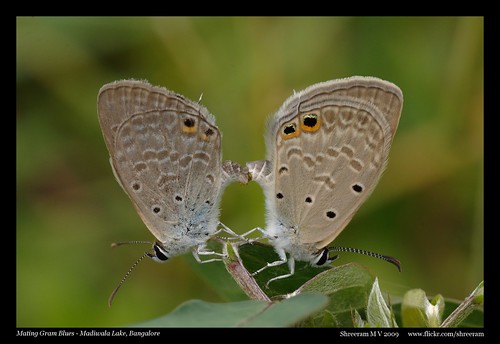
That was my first Macro photograph!
Encouraged by the result, I tried it out on Saturday morning again. And this was my second shot, this time of a Lesser Grass Blue.
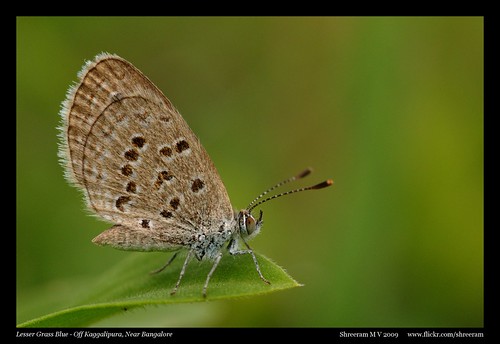
Learnings so far:
1) Use Manual Focus. Autofocus doesn't seem to be of much use, except for initial
"rough" focusing.
2) A Flash is good to have, especially because you'd be shooting with very small aperture.
3) Let the wind blow over!
One of the first obstacles to photographing insects is...it's hard to find one that sits still! And, as I discovered, the slightest movement is enough to lose focus.
And then I found this pair of Gram Blues that didn't mind the attention. They were busy with their job for over an hour giving me ample opportunity to try out different aspects of macro photography. Did you know that the butterfly family Lycaenidae (which includes Blues and the colorful Pierrots) constitutes 40% of all butterfly species?

That was my first Macro photograph!
Encouraged by the result, I tried it out on Saturday morning again. And this was my second shot, this time of a Lesser Grass Blue.

Learnings so far:
1) Use Manual Focus. Autofocus doesn't seem to be of much use, except for initial
"rough" focusing.
2) A Flash is good to have, especially because you'd be shooting with very small aperture.
3) Let the wind blow over!
Thursday, June 25, 2009
Blackbucks at Maidenahalli
Maidanhalli has long been on my list of places to see around Bangalore. Despite a tiring Saturday, I set off on Sunday morning with a couple of friends.
Just as we got off NH4, we came across a pond on our left side. On our right side was a rocky landscape, with a pair of Egyptian Vultures sitting atop. What a way to start the day! We trekked up the rock in an unsuccessful pursuit to photograph them. On our way down, a large dark-grey/brown bird with a long tail disappeared into a nearby tree. We tried to get close but it flew and landed on a rock. This was my first sighting of a Sirkeer Malkoha around Bangalore. Also, it was of a greyish brown color, compared to the pale brown ones that I had seen in Kanha.
Along the way, we saw a Common Hawk Cuckoo on a wire next to the road. It was mobbed by bulbuls very soon and flew to the safety of a mango grove nearby. A pair of eagles were jousting in the air and attacking each other with their talons.
Maidanahalli itself was fascinating and a tad disappointing.
First, the fascinating part. The grasslands are truly a sight to see. Rolling on unevenly, the sway of the grass is a treat to watch. Add a herd of blackbucks and it is magical.
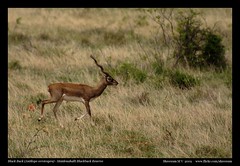
We saw herds of blackbucks ranging from 5 to 20 in numbers. They are very very shy and wouldn't let you anywhere close-by. The photograph above was shot from the forest department "pagoda" where we were resting after lunch. This lone male wandered close-by and allowed us a few shots before bounding away. Soon after, we also saw a hare bounding along the grasslands around the same place.
Birding was also awesome here. We saw a green bee-eater with a butterfly, taking its own sweet time to stun its prey and then swallow it in one gulp! Larks allowed us to get very close in the car and would then do a superb parachuting display and land close-by. We also saw a family of Yellow-wattled Lapwings with 2 juveniles. A huge number of lifers too - Southern Grey Shrike, Red-collared Dove and a flock of Grey Francolins - to make the day for me.
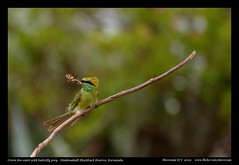
About the disappointing part, the sanctuary blends seamlessly into nearby villages. A 360 degree scan of the landscape never presents itself without agriculture in the backdrop. This causes a few issues, primarily grazing cattle and sheep in the sanctuary. A shepherd came up to us in the pagoda and started playing loud music on his mobile! What was saddening was that the blackbucks have to wait their turn while the sheep drink water from their water-hole. On our way back, we saw blackbucks venturing very close to farms in the villages around. A real pity!
How to get to Maidanahalli? - Maidanahalli is around 150km from Bangalore (a good 4-5hr drive). Drive to Tumkur. Beyond Tumkur, there is a diversion to Madhugiri (the locals would help you out with the exact road). Beyond Madhugiri, ask for directions to Jayamanagali forest or Maidanahalli.
A word of advice on planning a trip - Do a 2-day trip. Try to get Forest Dept permission to stay overnight at their forest bungalow. If you are successful, drive to Maidanahalli after lunch on Day 1. Check out the park and the wildlife till sunset. Spend the night there (you need to carry your own food). Do early morning birding and wildlife-watching. Have breakfast and start back to Bangalore.
Links:
List of Birds
Photographs
Just as we got off NH4, we came across a pond on our left side. On our right side was a rocky landscape, with a pair of Egyptian Vultures sitting atop. What a way to start the day! We trekked up the rock in an unsuccessful pursuit to photograph them. On our way down, a large dark-grey/brown bird with a long tail disappeared into a nearby tree. We tried to get close but it flew and landed on a rock. This was my first sighting of a Sirkeer Malkoha around Bangalore. Also, it was of a greyish brown color, compared to the pale brown ones that I had seen in Kanha.
Along the way, we saw a Common Hawk Cuckoo on a wire next to the road. It was mobbed by bulbuls very soon and flew to the safety of a mango grove nearby. A pair of eagles were jousting in the air and attacking each other with their talons.
Maidanahalli itself was fascinating and a tad disappointing.
First, the fascinating part. The grasslands are truly a sight to see. Rolling on unevenly, the sway of the grass is a treat to watch. Add a herd of blackbucks and it is magical.

We saw herds of blackbucks ranging from 5 to 20 in numbers. They are very very shy and wouldn't let you anywhere close-by. The photograph above was shot from the forest department "pagoda" where we were resting after lunch. This lone male wandered close-by and allowed us a few shots before bounding away. Soon after, we also saw a hare bounding along the grasslands around the same place.
Birding was also awesome here. We saw a green bee-eater with a butterfly, taking its own sweet time to stun its prey and then swallow it in one gulp! Larks allowed us to get very close in the car and would then do a superb parachuting display and land close-by. We also saw a family of Yellow-wattled Lapwings with 2 juveniles. A huge number of lifers too - Southern Grey Shrike, Red-collared Dove and a flock of Grey Francolins - to make the day for me.

About the disappointing part, the sanctuary blends seamlessly into nearby villages. A 360 degree scan of the landscape never presents itself without agriculture in the backdrop. This causes a few issues, primarily grazing cattle and sheep in the sanctuary. A shepherd came up to us in the pagoda and started playing loud music on his mobile! What was saddening was that the blackbucks have to wait their turn while the sheep drink water from their water-hole. On our way back, we saw blackbucks venturing very close to farms in the villages around. A real pity!
How to get to Maidanahalli? - Maidanahalli is around 150km from Bangalore (a good 4-5hr drive). Drive to Tumkur. Beyond Tumkur, there is a diversion to Madhugiri (the locals would help you out with the exact road). Beyond Madhugiri, ask for directions to Jayamanagali forest or Maidanahalli.
A word of advice on planning a trip - Do a 2-day trip. Try to get Forest Dept permission to stay overnight at their forest bungalow. If you are successful, drive to Maidanahalli after lunch on Day 1. Check out the park and the wildlife till sunset. Spend the night there (you need to carry your own food). Do early morning birding and wildlife-watching. Have breakfast and start back to Bangalore.
Links:
List of Birds
Photographs
Labels:
Maidanahalli,
nature,
photography,
safari,
travel,
wildlife
Wednesday, June 24, 2009
Kommaghatta Tank - Full of surprises
After an amazing trip to Ramanagara, we were all charged up to continue birding for the rest of the day. After an energy-boosting lunch, we headed off to Kommaghatta Tank.
When we got there, all we could see was a huge flock of Common Coots. Suddenly, one of us spotted a Pied Cuckoo on a wire. Very close to it, there was another one. They were flying around the shrubs in the plots meant for a residential layout. Red-vented Bulbuls and Ashy Prinias were mobbing them.

As we approached the reed beds, we were surprised with a lifer - Streaked Weavers. These shy birds were flying in and out of the reeds, hardly giving us an opportunity to watch them well and photograph them. Their nests on the reed beds are also so different from a Baya Weaver's nest.
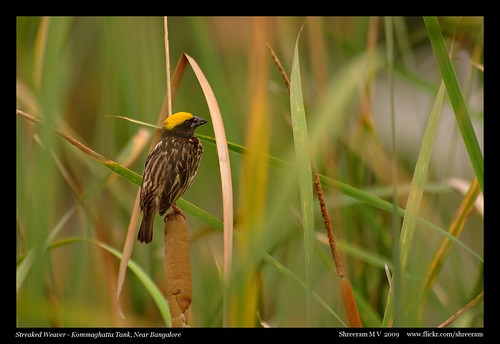
Although the Red Avadavat eluded us, we got to see a huge flock of Black-headed Munias.
Among water birds, Greater Cormorants and Oriental Darters were magnificent to watch. A Yellow Bittern made a brief appearance before disappearing into a tree. Just as we were leaving, a Common Kingfisher posed for us patiently. What an end to a great day of birding!
Where is Kommaghatta Tank? When driving towards Bangalore from Mysore, at Kengeri, there is a flyover under construction. At this point, there is a road that slopes upwards. Take that road and follow it till the first major junction. Take a left here and drive straight. You'll cross the NICE road atop a flyover. Kommaghatta Tank is just beyond the flyover on the right-hand side.
Links:
List of birds
Photographs
When we got there, all we could see was a huge flock of Common Coots. Suddenly, one of us spotted a Pied Cuckoo on a wire. Very close to it, there was another one. They were flying around the shrubs in the plots meant for a residential layout. Red-vented Bulbuls and Ashy Prinias were mobbing them.

As we approached the reed beds, we were surprised with a lifer - Streaked Weavers. These shy birds were flying in and out of the reeds, hardly giving us an opportunity to watch them well and photograph them. Their nests on the reed beds are also so different from a Baya Weaver's nest.

Although the Red Avadavat eluded us, we got to see a huge flock of Black-headed Munias.
Among water birds, Greater Cormorants and Oriental Darters were magnificent to watch. A Yellow Bittern made a brief appearance before disappearing into a tree. Just as we were leaving, a Common Kingfisher posed for us patiently. What an end to a great day of birding!
Where is Kommaghatta Tank? When driving towards Bangalore from Mysore, at Kengeri, there is a flyover under construction. At this point, there is a road that slopes upwards. Take that road and follow it till the first major junction. Take a left here and drive straight. You'll cross the NICE road atop a flyover. Kommaghatta Tank is just beyond the flyover on the right-hand side.
Links:
List of birds
Photographs
Tuesday, June 23, 2009
Soaring Vultures of Ramanagara - Trip report - 20 Jun, 2009
Saturday morning saw us drive to Ramanagara - the land of gigantic rocks, Sholay and, of course, vultures.
The first sighting of the Long-billed Vultures (Gyps Indicus) roosting high on the rocks was amazing. They look like small rocks from the ground. Also known as the Indian Vultures, they were previously clubbed together with the Slender-billed Vultures of NE India as a single species. They are among the worst hit by diclofenac. We spotted 7 of them on the rocks.
Since it was early morning, we decided to check out the Long-billed Pipit on the plains around the rocks. As is becoming common with most of my nature-watching visits, I startled a quail soon after we got there. An Indian Bushlark was singing and doing its parachuting display. A group of Scaly-breasted Munias were busy around a small tree. The number of butterflies fluttering around was sheer magic.
We spotted the Long-billed Pipit sitting majestically on the stump of a palm tree. It's a rare pipit (there is only 1 photo on INW).
We then decided to trek up to the top of the hill to view the vultures as they took off. As we approached the car, the Egyptian Vultures on the opposite rock had taken off and were doing their morning recce flights. We drove up to the base of the Ramadevara Hill and climbed the stairs. Midway, we took a diversion and trekked up the rock. As we climbed higher, the landscapes got more and more beautiful. By then, the vultures had taken off and it was a sight to see them soaring with their huge wings. They were flying back to their roost and taking off again. It was awesome.
I stopped a little way before the summit. The rest of the group got some interesting views and a pair of Long-billed Pipits as well.
This was insect kingdom. I've never seen such a wide assortment of butterflies, hoppers, bugs and spiders (even a green one!). A lot of them were totally new to me.

We trekked back to the steps and walked up to the temple in search of the Yellow-throated Bulbul. We heard them a few of times and saw fleeting glances. One of the tourists there alerted us of a tortoise. We discovered an Indian Pond Terrapin, possibly lost or looking for a nesting site, very close to the temple. I guess it would've wandered from the pool around the temple.
We finally saw the Yellow-throated Bulbul at the base of the stairs. An adult was feeding a spider to its young one. A little more butterfly-watching and we were off.
A fantastic trip and so many lifers too - Long-billed Vultures, Long-billed Pipit and Yellow-throated Bulbul, not to mention the butterflies.
Post-lunch, we proceeded to Kommaghatta Tank.
Links:
List of Birds
Photographs
The first sighting of the Long-billed Vultures (Gyps Indicus) roosting high on the rocks was amazing. They look like small rocks from the ground. Also known as the Indian Vultures, they were previously clubbed together with the Slender-billed Vultures of NE India as a single species. They are among the worst hit by diclofenac. We spotted 7 of them on the rocks.
Since it was early morning, we decided to check out the Long-billed Pipit on the plains around the rocks. As is becoming common with most of my nature-watching visits, I startled a quail soon after we got there. An Indian Bushlark was singing and doing its parachuting display. A group of Scaly-breasted Munias were busy around a small tree. The number of butterflies fluttering around was sheer magic.
We spotted the Long-billed Pipit sitting majestically on the stump of a palm tree. It's a rare pipit (there is only 1 photo on INW).
We then decided to trek up to the top of the hill to view the vultures as they took off. As we approached the car, the Egyptian Vultures on the opposite rock had taken off and were doing their morning recce flights. We drove up to the base of the Ramadevara Hill and climbed the stairs. Midway, we took a diversion and trekked up the rock. As we climbed higher, the landscapes got more and more beautiful. By then, the vultures had taken off and it was a sight to see them soaring with their huge wings. They were flying back to their roost and taking off again. It was awesome.
I stopped a little way before the summit. The rest of the group got some interesting views and a pair of Long-billed Pipits as well.
This was insect kingdom. I've never seen such a wide assortment of butterflies, hoppers, bugs and spiders (even a green one!). A lot of them were totally new to me.

We trekked back to the steps and walked up to the temple in search of the Yellow-throated Bulbul. We heard them a few of times and saw fleeting glances. One of the tourists there alerted us of a tortoise. We discovered an Indian Pond Terrapin, possibly lost or looking for a nesting site, very close to the temple. I guess it would've wandered from the pool around the temple.
We finally saw the Yellow-throated Bulbul at the base of the stairs. An adult was feeding a spider to its young one. A little more butterfly-watching and we were off.
A fantastic trip and so many lifers too - Long-billed Vultures, Long-billed Pipit and Yellow-throated Bulbul, not to mention the butterflies.
Post-lunch, we proceeded to Kommaghatta Tank.
Links:
List of Birds
Photographs
Friday, June 12, 2009
Nature-watching at Ragihalli and Turahalli - May 30 and 31
Saturday morning saw me driving towards Ragihalli. Our first stop was a ground around a kilometer after getting off the Bannerghatta-Jigani road. Just as we turned into the ground, we saw 3 female Indian Peafowls! This was my first sighting of our National Bird in Bangalore. They quickly disappeared into the undergrowth, giving me enough time to get a couple of record shots. We could hear their calls for more than hour after that.
We greeted the resident Yellow-wattled Lapwings with a few photographs and took a walk around the ground. We saw a small brown bird running in the grass ahead. A few record shots showed that it was a Barred Buttonquail (huge lifer for me)! It walked around for a minute before disappearing into a shrub. As we walked closer, we startled and were startled by a hare! This has been my second hare sighting in 3 weeks near Bangalore.
We drove to Ragihalli. The lake is almost dry now. A pair of Red-wattled Lapwings were crying out loud. I tried walking towards one of them when I was mobbed (almost) by its partner! It came flying straight towards me (I've always had lapwings fly away from me!) and turned away around 10 meters from me. I quickly left the area as I had no intention of disturbing them. There were a couple of pipits around. I didn't see the Large Grey Babblers that I had seen only the week before.
Sadly, the light was really bad (overcast skies) and couldn't get good shots. The list of birds from Ragihalli is here.
We were at Turahalli mini-forest on Sunday morning. The moment we got out of the car, we saw what would be the sight of the day for me (pardon me, but I am a hard-core raptor lover :)). A Changeable Hawk Eagle was perched on a tree close-by and was being mobbed by crows. We watched it for quite some time after which it flew away.
Turahalli is really beautiful. We trekked up 2 small hillocks and the sights we were treated to were amazing. All of us were impressed by huge copper-colored millipedes, which moved like miniature tanks over all obstacles in their way. We saw many agamid lizards basking in the sun. And the butterflies were lovely.
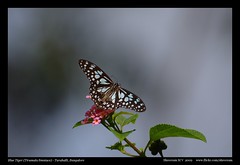


But what added most to the beauty of the place (in my opinion) were the flowers everywhere. From small grasses to eye-level flowering plants, they were everywhere at their colorful best.
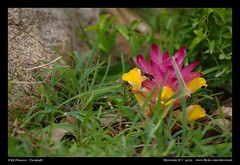

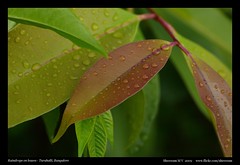

The biggest regret though is not able to see the nightjar that was (possibly) roosting on the ground. I was less than a foot away when it flew away. We tried following it but its camoflage was too good for us.
As for the birding, the list is here.
We greeted the resident Yellow-wattled Lapwings with a few photographs and took a walk around the ground. We saw a small brown bird running in the grass ahead. A few record shots showed that it was a Barred Buttonquail (huge lifer for me)! It walked around for a minute before disappearing into a shrub. As we walked closer, we startled and were startled by a hare! This has been my second hare sighting in 3 weeks near Bangalore.
We drove to Ragihalli. The lake is almost dry now. A pair of Red-wattled Lapwings were crying out loud. I tried walking towards one of them when I was mobbed (almost) by its partner! It came flying straight towards me (I've always had lapwings fly away from me!) and turned away around 10 meters from me. I quickly left the area as I had no intention of disturbing them. There were a couple of pipits around. I didn't see the Large Grey Babblers that I had seen only the week before.
Sadly, the light was really bad (overcast skies) and couldn't get good shots. The list of birds from Ragihalli is here.
We were at Turahalli mini-forest on Sunday morning. The moment we got out of the car, we saw what would be the sight of the day for me (pardon me, but I am a hard-core raptor lover :)). A Changeable Hawk Eagle was perched on a tree close-by and was being mobbed by crows. We watched it for quite some time after which it flew away.
Turahalli is really beautiful. We trekked up 2 small hillocks and the sights we were treated to were amazing. All of us were impressed by huge copper-colored millipedes, which moved like miniature tanks over all obstacles in their way. We saw many agamid lizards basking in the sun. And the butterflies were lovely.



But what added most to the beauty of the place (in my opinion) were the flowers everywhere. From small grasses to eye-level flowering plants, they were everywhere at their colorful best.




The biggest regret though is not able to see the nightjar that was (possibly) roosting on the ground. I was less than a foot away when it flew away. We tried following it but its camoflage was too good for us.
As for the birding, the list is here.
Monday, June 08, 2009
"Kuch dikha kya?" aka Kanha - Tiger, Shows and Traffic Woes...
Kanha is visited primarily for one of its denizens - the Bengal Tiger (Panthera Tigris Tigris). The royalty, taking a walk in the meadows, is truly an experience to behold!

We spotted tigers on 5 of 8 safaris. It was fantastic, especially because I hadn't seen one before. For once, I was thankful to be in the safari jeep than off it :)
Prey is aplenty here. From the tiger's fave food - sambar - to chital to barasigha, the buffet is varied too. One of the groups from the workshop actually saw a tiger attempt a hunt!
We would've, too, if it was not closing time for the park. Read the story by clicking the photograph below.

THE HUMAN EFFECT
The eagerness to see a tiger translates into extensive human interference in the visitor zone at Kanha. Each day, more than 100 safari vehicles make 2 trips into the park. This literally causes traffic jams in the forest, sometimes accidents too.
There is a code when a jeep meets another on the safari - "Kuch dikha kya?" (Did you see anything?"). Of course, the "kuch" refers to the tiger. The obsession with the tiger is really amusing. According to our safari driver, some groups turn back 10 minutes into the safari if they see one close to the park entrance.
Another unique thing here is a Tiger Show. Every morning, a group of mahouts on their elephants head out into the forest. When a tiger is spotted, the elephants surround it, subdue it and force it to stay put. Wireless messages are sent out to the park ticket counters. Tourists can buy special tickets and be "treated" to a tiger sighting on elephant-back.
I went to 2 of the Tiger shows. One of the tigers was peaceful as he had just eaten (the spotted deer remains were carefully hidden under the grass close by) and was relaxing in a water hole. The other one seemed to be forced out of its water hole to a corner and was on alert. As a photographer, both gave me terrible shots due to the angle (looking down from elephant-back). As a nature-lover, I didn't like it because it was just not natural. The agitated/scared look of the tiger was moving.
As a pragmatist, I think its good in a way. People get to see what they want, increasing the park revenue. This in turn, hopefully, boosts the maintenance of our remaining forest cover and conservation. Tormenting a tiger to ensure the remaining survive might not be a bad idea.
PARTING THOUGHTS
The tiger has been feared, revered, admired and hunted for a very long time. The last, sadly, overtook the first three over the 19th and 20th centuries. Combined with population explosion of another mammal (overselves), it has endangered this huge cat. Tomorrow, we might be left with tales to hear and photographs to see of this "king of the jungle".
We may be proud to be Indians. But, we need to translate that pride into action if our descendants are to continue the "Kuch dikha kya?" tradition and still refer to our National Animal.

We spotted tigers on 5 of 8 safaris. It was fantastic, especially because I hadn't seen one before. For once, I was thankful to be in the safari jeep than off it :)
Prey is aplenty here. From the tiger's fave food - sambar - to chital to barasigha, the buffet is varied too. One of the groups from the workshop actually saw a tiger attempt a hunt!
We would've, too, if it was not closing time for the park. Read the story by clicking the photograph below.

THE HUMAN EFFECT
The eagerness to see a tiger translates into extensive human interference in the visitor zone at Kanha. Each day, more than 100 safari vehicles make 2 trips into the park. This literally causes traffic jams in the forest, sometimes accidents too.
There is a code when a jeep meets another on the safari - "Kuch dikha kya?" (Did you see anything?"). Of course, the "kuch" refers to the tiger. The obsession with the tiger is really amusing. According to our safari driver, some groups turn back 10 minutes into the safari if they see one close to the park entrance.
Another unique thing here is a Tiger Show. Every morning, a group of mahouts on their elephants head out into the forest. When a tiger is spotted, the elephants surround it, subdue it and force it to stay put. Wireless messages are sent out to the park ticket counters. Tourists can buy special tickets and be "treated" to a tiger sighting on elephant-back.
I went to 2 of the Tiger shows. One of the tigers was peaceful as he had just eaten (the spotted deer remains were carefully hidden under the grass close by) and was relaxing in a water hole. The other one seemed to be forced out of its water hole to a corner and was on alert. As a photographer, both gave me terrible shots due to the angle (looking down from elephant-back). As a nature-lover, I didn't like it because it was just not natural. The agitated/scared look of the tiger was moving.
As a pragmatist, I think its good in a way. People get to see what they want, increasing the park revenue. This in turn, hopefully, boosts the maintenance of our remaining forest cover and conservation. Tormenting a tiger to ensure the remaining survive might not be a bad idea.
PARTING THOUGHTS
The tiger has been feared, revered, admired and hunted for a very long time. The last, sadly, overtook the first three over the 19th and 20th centuries. Combined with population explosion of another mammal (overselves), it has endangered this huge cat. Tomorrow, we might be left with tales to hear and photographs to see of this "king of the jungle".
We may be proud to be Indians. But, we need to translate that pride into action if our descendants are to continue the "Kuch dikha kya?" tradition and still refer to our National Animal.
Sunday, May 31, 2009
The birds of Kanha - Part 2 of Kanha series
The sounds of the jungle are enchanting. I guess they bring back the nostalgia still embedded in our genes. For, not very long ago, we were an integral (and rapidly evolving) part of these very jungles that we've now run over to create civilization...
Turn off the engine of the safari vehicle at Kanha and listen to the sounds around. You would definitely not miss the frantic song of the Common Hawk Cuckoo. The song that sounds like "Brain-Fe-ver" rings all over the place. Not too far behind, another cuckoo - this time the Indian cuckoo - wants "One more bottle". Puff-throated babblers render their wonderful song hidden in the undergrowth. Barbets call from the tree tops. An Indian Peafowl gives out an alarm call from far away. A shrill whistle shows the Crested Serpent Eagle gliding overhead. The orchestra is truly wonderful!
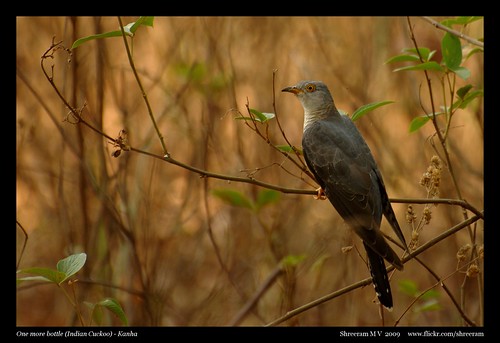
Kanha plays host to around 280 species of birds. At least 52 of the 77 families of birds found in India are represented here (source).
Cattle egrets were hitching rides on patient gaurs. In breeding plumage, these common birds look really beautiful. Rollers seemed to not mind the people around and flashed a brilliant blue when they flew. Racket-tailed drongos were a sight to watch, with their long streamers floating behind them as they flew from tree to tree. The very shy Red Junglefowl ran from the safari path into the jungle at the sound of an approaching vehicle. Jungle babblers flew from one place to another in flocks.
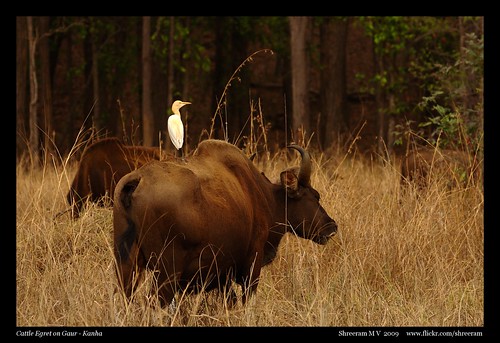
Our national bird, the Indian Peafowl, was at its majestic best. The very famous display of this colorful bird was a treat to watch, despite seeing at least a couple of them on every safari. I saw the Indian Pitta, another very colorful bird, atop trees for the very first time (I've always seen them in the undergrowth in Bangalore).
The area around Bahmni Dadar was a particularly different habitat. A Peregrine Falcon (wish I could've got a photograph) was looking for prey. White-rumped Shamas were singing at their melodious best. An Emerald Dove posed for the cameras, before disappearing.
Among raptors (I somehow like them a lot), Spotted Owlets, Crested Serpent Eagles and Oriental Honey Buzzards were most often spotted. A resident Black-winged Kite made its appearance close to the Kisli gate on all safaris. I also saw a lot of firsts - Peregrine Falcon, White-eyed Buzzard, Eurasian Sparrowhawk and White-rumped Vultures. A personal favorite from the trip was a late evening sighting of a Changeable Hawk Eagle with a catch. A Racket-tailed Drongo (another very common, yet shy bird at Kanha) was unsuccessfully trying to mob it. The eagle chased away the drongo and went about the dinner routine.

The complete list of birds seen can be found here.
Turn off the engine of the safari vehicle at Kanha and listen to the sounds around. You would definitely not miss the frantic song of the Common Hawk Cuckoo. The song that sounds like "Brain-Fe-ver" rings all over the place. Not too far behind, another cuckoo - this time the Indian cuckoo - wants "One more bottle". Puff-throated babblers render their wonderful song hidden in the undergrowth. Barbets call from the tree tops. An Indian Peafowl gives out an alarm call from far away. A shrill whistle shows the Crested Serpent Eagle gliding overhead. The orchestra is truly wonderful!

Kanha plays host to around 280 species of birds. At least 52 of the 77 families of birds found in India are represented here (source).
Cattle egrets were hitching rides on patient gaurs. In breeding plumage, these common birds look really beautiful. Rollers seemed to not mind the people around and flashed a brilliant blue when they flew. Racket-tailed drongos were a sight to watch, with their long streamers floating behind them as they flew from tree to tree. The very shy Red Junglefowl ran from the safari path into the jungle at the sound of an approaching vehicle. Jungle babblers flew from one place to another in flocks.

Our national bird, the Indian Peafowl, was at its majestic best. The very famous display of this colorful bird was a treat to watch, despite seeing at least a couple of them on every safari. I saw the Indian Pitta, another very colorful bird, atop trees for the very first time (I've always seen them in the undergrowth in Bangalore).
The area around Bahmni Dadar was a particularly different habitat. A Peregrine Falcon (wish I could've got a photograph) was looking for prey. White-rumped Shamas were singing at their melodious best. An Emerald Dove posed for the cameras, before disappearing.
Among raptors (I somehow like them a lot), Spotted Owlets, Crested Serpent Eagles and Oriental Honey Buzzards were most often spotted. A resident Black-winged Kite made its appearance close to the Kisli gate on all safaris. I also saw a lot of firsts - Peregrine Falcon, White-eyed Buzzard, Eurasian Sparrowhawk and White-rumped Vultures. A personal favorite from the trip was a late evening sighting of a Changeable Hawk Eagle with a catch. A Racket-tailed Drongo (another very common, yet shy bird at Kanha) was unsuccessfully trying to mob it. The eagle chased away the drongo and went about the dinner routine.

The complete list of birds seen can be found here.
Subscribe to:
Posts (Atom)


